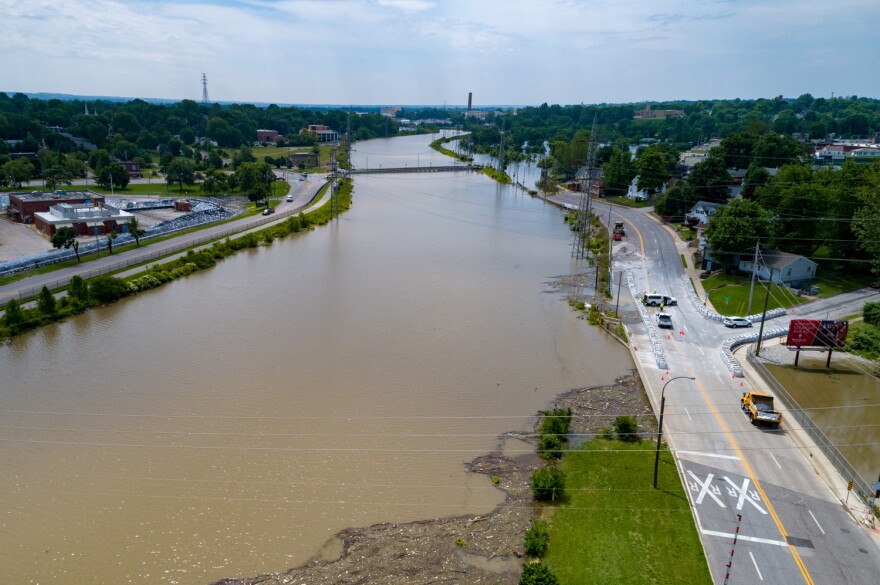Andrea Mcmanus and her three children had lived in their apartment in Grafton for less than six months before they evacuated to escape the rising Mississippi River floodwaters.
They left on March 22, as the flood overtook Grafton and began rising downstream in St. Louis. The Mississippi has been above flood stage at St. Louis for more than 80 days and last weekend surpassed the 1973 level, the second highest on record.
Many residents, government officials and scientists compare it to the Great Flood of 1993, when the river crested at 49.6 feet, the highest flood on record for the St. Louis region. Some residents worry that it could surpass that height.
“You live on the river, you know you can wait it out,” Mcmanus said. “But this year, they say, I’m sure it’ll probably get worse than ‘93.”
The flood of 1993 lasted for 104 days. The current flood will last longer, said Dave Busse, chief engineer at the Army Corps of Engineers’ St. Louis District.
“If you remember ‘93, we started with a flood early, around Easter, went below flood stage, then we started up again,” Busse said Monday at a media briefing. “This flood will be consecutively more days on those levees.”
The National Weather Service predicts that the Mississippi River will crest at 45.8 feet Saturday, just four feet shy of the flood of ‘93. That may not be the highest crest this summer, said Bob Criss, a geologist at Washington University.
“Whether that’s the crest of the year, boy, I’m not so sure,” Criss said. “We could still have a very severe flood.”

For the flood to approach the 1993 level in St. Louis, that would require more rainfall, said Jonathan Remo, a geographer at Southern Illinois University Carbondale.
“If we get a lot more rain over the next couple days to weeks, we could exceed 1993,” Remo said, “but right now the forecast isn’t calling for that.”
The flood of 1993 and the current flood largely differ in where the water is coming from. Historically, large floods in the past have been driven by the Missouri River, Criss said.
“This flood is coming from the north,” Criss said. “More than half the water in the current Mississippi River by St. Louis is from the Upper Mississippi. In 1993, almost 75% of the water was coming down from the Missouri River.”
If the Missouri River were to receive more rainfall, that could create a “big mess,” Criss said.
Some residents in Grafton and West Alton had to abandon their homes this year. But there were many more people living in flooded areas during 1993. After the record flood, the Federal Emergency Management Agency bought more than 4,000 residential properties in Missouri.
Corps officials also say that the levees that protect urban communities in the St. Louis area are much stronger now. More than $100 million in federal, state and local funds has been spent on improving them over the last 26 years, said Dave Busse of the St. Louis District.
“I would be extremely concerned if we had the levees we had in ‘93 now,” Busse said.

But scientists are more worried about what’s driving major floods than in 1993. Criss, Remo and other researchers published several studies that show that levees, dams and other manmade structures can constrict rivers and worsen flooding. There’s also been increasing research to show that river flooding has escalated in the Midwest because of climate change.
Scientists say it's hard to determine how much climate change factors in the current flood.
“That’s a good question,” Remo said. “I don’t know if I can answer that. That gets into attribution science.”
As flooding along major rivers, like the Mississippi and the Missouri, become more intense and frequent, some environmentalists say it’s time for the Corps of Engineers to change how they predict flooding and manage rivers. The probabilities used to calculate how often a major flood could occur are outdated, said David Stokes, executive director of the Great Rivers Habitat Alliance.
“This is a new normal,” Stokes said. “How many times can we have a 100-year flood either on the Mississippi, the Meramec or the Missouri every year before we realize that those terms are useless and what we’ve done has so changed the river systems that we need to throw out all prior measurements?”
The Corps St. Louis District estimates that the 1993 flood was a 350-year flood, a flood that has a 0.3% chance of happening in any given year. Criss at Washington University has argued that the flood is more accurately a 50-year flood, which has a 2% chance of happening in any given year.

At the Gateway Arch, visitors this week saw the Mississippi take over several steps near the park grounds.
“In ‘93, I can remember, the water came up the Arch steps even higher,” said Cindy Derse of Valley Park. “It was at least to this next level up higher. It was even more massive, really incredible. Just the force of nature.”
Follow Eli on Twitter: @StoriesByEli
Send questions and comments about this story to feedback@stlpublicradio.org







